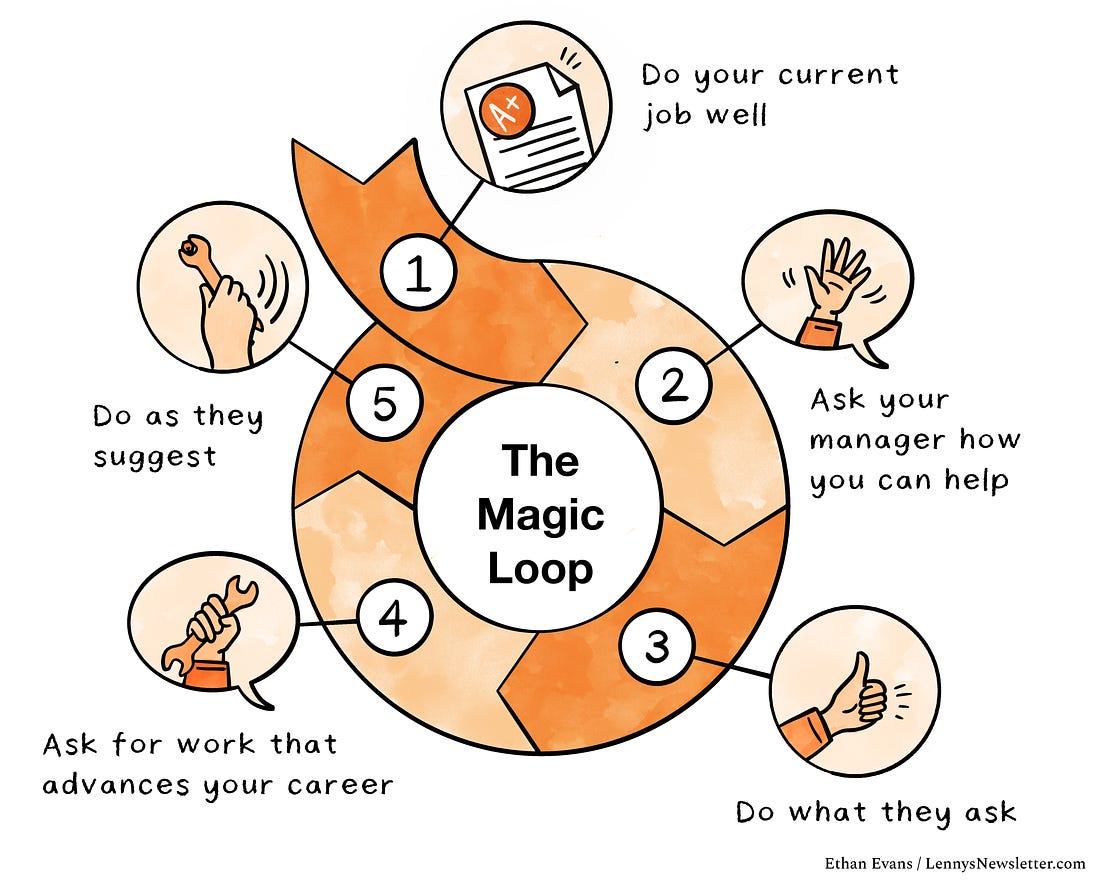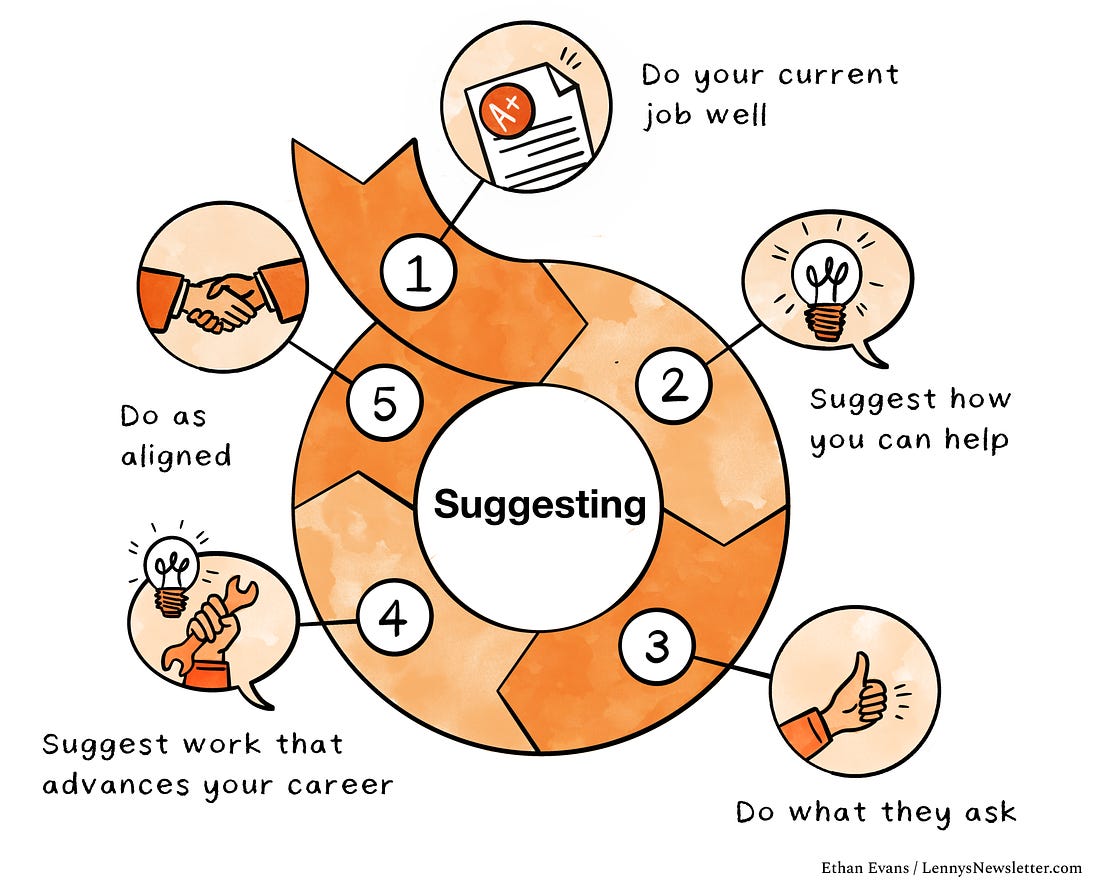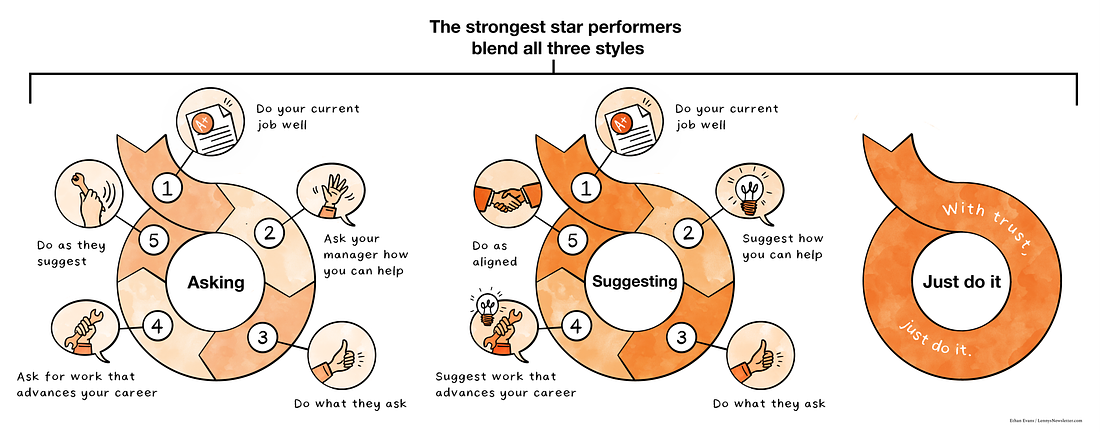Lenny's Newsletter - The Magic Loop
👋 Hey, I’m Lenny and welcome to a 🔒 subscriber-only edition 🔒 of my weekly newsletter. Each week I tackle reader questions about building product, driving growth, and accelerating your career. Taking a short break from the B2B series, I’m thrilled to bring you an important guest post by Ethan Evans. During his 15 years at Amazon, Ethan helped invent Prime Video, Amazon Video, Amazon Appstore, Prime Gaming (formerly Twitch Prime), and Twitch Commerce. He led global teams of 800+, holds 70+ patents, and helped push for and draft one of Amazon’s fourteen core Leadership Principles, “Ownership.” Below, for the first time publicly, Ethan shares one of his most important career frameworks, The Magic Loop. This framework helped him rise quickly in his own career, and has helped countless mentees and direct reports rise in theirs. I’m excited to share it with you here, and I can’t wait to hear from y’all about how it goes when you implement. Ethan is now working as a writer, coach, and course instructor. He writes a newsletter, Level Up, which publishes candid career advice 2 times per week, and offers a range of Leadership Development Courses that go in-depth on topics like Breaking Through to Executive, Managing Up Successfully, Leadership Networking, and more. If you’d like to connect, you can find Ethan on LinkedIn.  The Magic Loop is a process through which any employee may systematically grow at a company. It is reliable in its results, with a simple core of five basic steps. In this post, we first present the Loop in its most straightforward model. We then follow up with variations, optimizations, and special circumstances that users will find over time. Asking to do moreIn my first job, I went from having just left graduate school to managing a team of 10 in just two years. I did this by seeing unmet needs and asking my manager about filling them. I’ve repeated this pattern throughout my career, all the way up to my last role at Amazon. It worked at every step along the way. In my second job, I was hired as a director, then given more responsibility through an acquisition. In my third job, I was promoted to vice president before I turned 30. At Amazon, my responsibilities grew from an initial team of six to more than 800. Along the way, I helped create household products you would recognize, including Prime Video, Kindle, Alexa, Twitch, and Prime Gaming. At every step, I followed the Magic Loop. Since then I have worked with both leaders on my team and clients of my coaching practice to use the Magic Loop themselves. It worked for them and can work for you. The Magic LoopThe heart of the Magic Loop consists of five steps. Some of these steps will require substantial time and effort, but they lead to not just rapid career growth but also a great relationship with your manager. The Loop is used to grow both your personal skills and abilities as well as your career, responsibilities, and compensation. The steps:
 Why the magic worksThe “magic” in this loop relies on simple human nature. We have a natural sense of fair play and partnership, and we want to invest in people we view as having our best interests at heart. The magic in the loop is building a collaborative, mutually beneficial relationship. We will also cover exceptions, such as the rare manager who is exploitative or dishonest, later in this discussion. The core loopStep 1: Do your current job wellManagers always need help. They always have work that needs to be done and are wondering how to get it all done. As a result, they normally welcome offers of help and look positively on those making such an offer. The exception to this is when they feel that the person asking is not doing their current job well. In that case, what they are thinking is, “The way you could help is to do what I have already asked you to do, well and on time.” Therefore, before you can move to step two of the Magic Loop, you need to first be an employee in good standing in terms of performance with your current responsibilities. Note that this is an ongoing challenge. Workplaces and projects change. Further, when you practice the steps in the Loop, over time you will take on new responsibilities and you may struggle with them. Thus it is important to verify with your manager that you are doing your current job well. The simplest way to do this is to ask, in a non-threatening manner. This is not hard to do but can be scary, because there is the possibility that the manager will say no and ask for improvements. A good way to ask is to wait until a relatively quiet time, when there is no crisis going on (or less of one than usual, for a chaotic workplace), and ask your manager if you can talk with them for a few minutes. Sit down (a non-threatening posture) and say something like, “It’s been a while since I last checked in with you. I want to do a good job here and be helpful. I was wondering if you could tell me how you feel I am doing.” Then, no matter what they say in response, say thank you. Do not argue. At most, ask for an example if you receive a complaint. The rest of how to take feedback well is another topic beyond our scope in this article. If the feedback you got when you asked was basically good, you are clear to move on to step two. If not, you must address the feedback and re-verify good job performance before moving on. At my first job, where I did quality-control work for equipment made by our partner company, the engineering manager at that company complained that I was disrupting his team. He was nice about it; he told me he could see that I was trying to help and had good intentions, but that I was pestering his engineers about problems so much that they could not focus. I was working hard and I was calling out valid problems. In my eyes, I was doing my job and succeeding. But the way I was doing my work was causing problems for others. Few people intentionally do poor work. But without asking for feedback, you may have no idea how your work is being received. I learned to prioritize the problems I found and channel them through a process. I could only take on more once I addressed the feedback. Step 2: Ask your manager how you can helpOnce you are seen as doing great work and have your current job under control, ask your boss what more you can do to help them. Managers always need help. For some managers, they may need a bit of prompting if offers to help are unusual in your workplace. Some managers can be suspicious of such offers or may not have anything in mind right at that instant. In such cases, offer to check back in a week or so, giving them time to think about it. Often, once a manager knows you are willing to help, they will come to you with a request the next time a need arises. One great way to shortcut this process is to raise your hand or volunteer when a new task comes up. Often in a meeting, something will come up that needs to be done, and the manager will be trying to figure out who to give it to. Some of your peers will be looking down at their laptops or phones, trying to avoid being chosen. The easiest way to help your manager is to simply volunteer to take on the task. It is clear that it is something that your manager wants to have done, and you can be the hero. Believe me, as a manager, we notice who steps up to help us. Step 3: Do what you are askedOnce a manager makes a request, even if it was not the work you were hoping for, make an honest attempt to help. It is natural to want to be assigned the new, high-profile work, or tasks that perfectly suit our interests. However, often what managers need help with are the more operational tasks. In software engineering, the classic examples of such work fall into the maintenance category—migrating servers, applying patches, and fixing bugs. Good managers want to balance the work and match it to their employees’ desires. If you really want to get the most impact from step three, it may help if you take on an extra share of some of the work that others may be avoiding or that may not be getting done at all. You’ll be able to turn this into credit to move your career forward in the next step! Do the work as well as you can. You must meet the bar of step one (do a good job) with this work to continue. If the work is truly beyond your skills (not your willingness), then you will need to be politely clear about that and ask for pointers, resources, or aid in doing the work. Be clear that you are willing to do all you can but that you are concerned about failing and leaving the manager worse off. Frame any request like this in terms of helping the manager (protecting them from your nascent ability) rather than about you (say, that you are afraid of the challenge or the hard work). Step 4: Ask your manager how you can help, in line with one of your career goalsAfter you are doing a good job and have shown that you can and will put in extra effort to help out by completing steps one through three of the Magic Loop, you will be in a position to ask for work that helps you advance a career goal. This is because it is human nature to be inclined to help those who have helped you. So after you have first helped out the manager, they are more likely to help you in return. Note that if you have a good manager who invests in the careers of their team members, you may be able to skip step three altogether and jump straight here. This depends on your manager—if they have shown interest in growing the careers and abilities of their team members, then you can go straight to asking for the work that helps you grow. I have confirmed again and again with many managers that they are very rarely offered help and that they appreciate it. Simply the act of offering help will make you stand out. To move to this step, you have to have some idea of what you would like to achieve. This can be anything from learning a new skill to developing an ability you already have. It can also include getting more responsibility, a raise, or a promotion. If your goal is simple, you can ask directly in one statement, as in “Is there a way I could help you out while working with [piece of technology or specific skill] so that I can learn and improve?” If your goal is more complex, such as a major promotion, you probably cannot ask in one large request, such as “Is there a way I can help so that I can be promoted?” Rather, you have to frame it and say, “One day I’d like to be promoted. Could I help out in a way that you think would develop me toward that goal?” Lenny has already written a great article about the kinds of performance reviews a good manager should deliver. As you work with your manager, you can use this as a model of the kind of feedback and detailed plans you want to develop with them. Step 5: Repeat the loopYou may wonder why the “repeat” part needs any explanation. Partly, it depends on where you repeat. Sometimes you only go back to step four and do something else that both helps you grow or advance and that helps your manager. Sometimes you have to revisit step one and make sure that you are doing a great job even with new and more challenging tasks. Finally, you may have to update your goals or make sure that your manager is clear and on board with them. So, for example, if your goal is a raise or promotion, you may need to make sure that you and your manager are aligned on exactly what that will take. I asked for opportunities and promotions many times in my career. I was also constantly asked about growth and promotion by my direct reports. I am proud to say that my top-performing direct reports now hold higher positions than I did when I retired. People who worked for me are now company founders and executives all over the industry. As one specific example, a young man who came to me in 2005 as a Software Engineer II at Amazon went on to be a VP of Engineering at Google and has recently joined a new company as an Executive Vice President. He did it through the Magic Loop—by doing a great job, asking for more, and then doing that new work well. Advanced forms of the Magic LoopThe Magic Loop is strong, but you can make it even stronger. Once you master the basics and begin building a collaborative relationship with your manager, the methods in this section will let you take it even further. 1. Suggest your own ideasIn the simple form of the Magic Loop, you ask your manager what they need help to accomplish. However, as you understand your group and your company, you should be able to anticipate what needs to be done. In this model you evolve from asking what needs to be done to suggesting things that you can do that you believe will help. This approach involves confirming your ideas rather than simply offering help. To suggest an idea, use language like “Manager, I noticed that we are often late on projects because we forget to account for vacation schedules and then someone critical is out. I’ve been thinking that I could implement a step in our planning and update process that captures these. Would that be helpful, or is there something else you would like me to do?” Note that the ending question is very important. It both asks if this would be helpful and it implies the offer to do something else that the manager prefers if they have other priorities. This kind of response makes managers feel comfortable that they have the choice, but avoids the need for them to come up with the ideas. Managers will start seeing you as more than just helpful; they will see you as innovative and proactive as well.  2. Just do itUltimately, as you learn your manager’s and company’s style well, you can slowly start to just do what you see that needs to be done. That is, as trust with your manager grows, you can simply see what is needed, know what the manager will likely want done, do it, and mention it in your next discussion. “I noticed we often miss vacations in our schedules. I went ahead and fixed that by adding a step to solicit and document holiday plans with the team.” At this point, your manager will start to see you as helpful, innovative, and autonomous. This is the best thing for a manager—someone who does their job and who then additionally magically helps out without needing to be asked or told. As my career progressed, I changed almost entirely to this final style. I would see what my business at Amazon that I owned as a vice president needed in order to grow and succeed, and I would just go do it. The strongest star performers blend all three styles. Occasionally it is good to ask your manager what they need, because they may have needs based on information outside of your purview. It is also good to get their input on your biggest suggestions so that they can help make them better and feel part of the result. Finally, it is fastest to simply see what is needed and get it done. A blend of approaches, a collaborative team effort between you and your manager, is the end goal. You know you have succeeded when your relationship with your manager is less of a boss/employee structure and more of a partnership.  Frequently asked questions about the Magic LoopIf I keep volunteering for work, won’t I end up being overloaded?...Subscribe to Lenny's Newsletter to read the rest.Become a paying subscriber of Lenny's Newsletter to get access to this post and other subscriber-only content. A subscription gets you:
|
Older messages
Thank you for supporting Lenny's Newsletter
Monday, September 18, 2023
Thank you for reading Lenny's Newsletter. As a token of our appreciation, we're offering you a limited-time offer of 20% off a paid subscription for your first year. Redeem special offer Here
Picking sharp problems, increasing virality, and unique product frameworks | Oji Udezue (Typeform, Twitter, Calend…
Sunday, September 17, 2023
Listen now (76 mins) | Brought to you by Jira Product Discovery—Atlassian's new prioritization and roadmapping tool built for product teams — Oji Udezue is Chief Product Officer at Typeform and has
How to become a category pirate | Christopher Lochhead (author of Play Bigger, Niche Down, Category Pirates, more)
Sunday, September 17, 2023
Listen now (109 mins) | Brought to you by Mixpanel—Event analytics that everyone can trust, use, and afford | Vanta—Automate compliance. Simplify security | Round—The private network built by tech
A guide for finding product-market fit
Tuesday, September 12, 2023
Part five of my seven-part series on kickstarting and scaling a B2B business
500,000
Monday, September 11, 2023
Ten lessons learned from building this newsletter
You Might Also Like
🚀 Ready to scale? Apply now for the TinySeed SaaS Accelerator
Friday, February 14, 2025
What could $120K+ in funding do for your business?
📂 How to find a technical cofounder
Friday, February 14, 2025
If you're a marketer looking to become a founder, this newsletter is for you. Starting a startup alone is hard. Very hard. Even as someone who learned to code, I still believe that the
AI Impact Curves
Friday, February 14, 2025
Tomasz Tunguz Venture Capitalist If you were forwarded this newsletter, and you'd like to receive it in the future, subscribe here. AI Impact Curves What is the impact of AI across different
15 Silicon Valley Startups Raised $302 Million - Week of February 10, 2025
Friday, February 14, 2025
💕 AI's Power Couple 💰 How Stablecoins Could Drive the Dollar 🚚 USPS Halts China Inbound Packages for 12 Hours 💲 No One Knows How to Price AI Tools 💰 Blackrock & G42 on Financing AI
The Rewrite and Hybrid Favoritism 🤫
Friday, February 14, 2025
Dogs, Yay. Humans, Nay͏ ͏ ͏ ͏ ͏ ͏ ͏ ͏ ͏ ͏ ͏ ͏ ͏ ͏ ͏ ͏ ͏ ͏ ͏ ͏ ͏ ͏ ͏ ͏ ͏ ͏ ͏ ͏ ͏ ͏ ͏ ͏ ͏ ͏ ͏ ͏ ͏ ͏ ͏ ͏ ͏ ͏ ͏ ͏ ͏ ͏ ͏ ͏ ͏ ͏ ͏ ͏ ͏ ͏ ͏ ͏ ͏ ͏ ͏ ͏
🦄 AI product creation marketplace
Friday, February 14, 2025
Arcade is an AI-powered platform and marketplace that lets you design and create custom products, like jewelry.
Crazy week
Friday, February 14, 2025
Crazy week. ͏ ͏ ͏ ͏ ͏ ͏ ͏ ͏ ͏ ͏ ͏ ͏ ͏ ͏ ͏ ͏ ͏ ͏ ͏ ͏ ͏ ͏ ͏ ͏ ͏ ͏ ͏ ͏ ͏ ͏ ͏ ͏ ͏ ͏ ͏ ͏ ͏ ͏ ͏ ͏ ͏ ͏ ͏ ͏ ͏ ͏ ͏ ͏ ͏ ͏ ͏ ͏ ͏ ͏ ͏ ͏ ͏ ͏ ͏ ͏ ͏ ͏ ͏ ͏ ͏ ͏ ͏ ͏ ͏ ͏ ͏ ͏ ͏ ͏ ͏ ͏ ͏ ͏ ͏ ͏ ͏ ͏ ͏ ͏ ͏ ͏ ͏ ͏ ͏ ͏ ͏ ͏ ͏ ͏ ͏
join me: 6 trends shaping the AI landscape in 2025
Friday, February 14, 2025
this is tomorrow Hi there, Isabelle here, Senior Editor & Analyst at CB Insights. Tomorrow, I'll be breaking down the biggest shifts in AI – from the M&A surge to the deals fueling the
Six Startups to Watch
Friday, February 14, 2025
AI wrappers, DNA sequencing, fintech super-apps, and more. ͏ ͏ ͏ ͏ ͏ ͏ ͏ ͏ ͏ ͏ ͏ ͏ ͏ ͏ ͏ ͏ ͏ ͏ ͏ ͏ ͏ ͏ ͏ ͏ ͏ ͏ ͏ ͏ ͏ ͏ ͏ ͏ ͏ ͏ ͏ ͏ ͏ ͏ ͏ ͏ ͏ ͏ ͏ ͏ ͏ ͏ ͏ ͏ ͏ ͏ ͏ ͏ ͏ ͏ ͏ ͏ ͏ ͏ ͏ ͏ ͏ ͏ ͏ ͏ ͏ ͏ ͏ ͏ ͏ ͏ ͏
How Will AI-Native Games Work? Well, Now We Know.
Friday, February 14, 2025
A Deep Dive Into Simcluster ͏ ͏ ͏ ͏ ͏ ͏ ͏ ͏ ͏ ͏ ͏ ͏ ͏ ͏ ͏ ͏ ͏ ͏ ͏ ͏ ͏ ͏ ͏ ͏ ͏ ͏ ͏ ͏ ͏ ͏ ͏ ͏ ͏ ͏ ͏ ͏ ͏ ͏ ͏ ͏ ͏ ͏ ͏ ͏ ͏ ͏ ͏ ͏ ͏ ͏ ͏ ͏ ͏ ͏ ͏ ͏ ͏ ͏ ͏ ͏ ͏ ͏ ͏ ͏ ͏ ͏ ͏ ͏ ͏ ͏ ͏ ͏ ͏ ͏ ͏ ͏ ͏ ͏ ͏ ͏ ͏ ͏ ͏ ͏ ͏ ͏ ͏
